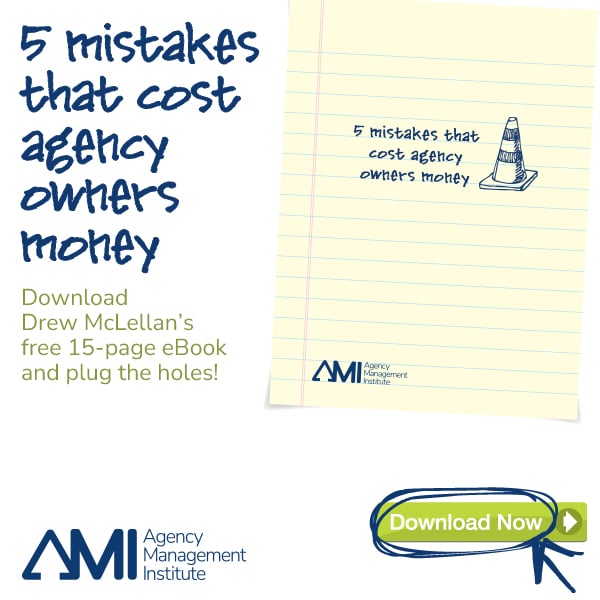These days, agencies tend to get caught up in near-constant talk of creativity, innovation, and disruption. But all that noise can drown out the real reason you’re in this business: to make money.
The truth is that you’re trying to make a living — for yourself, your family, and your employees. And no matter how hard you work to serve clients, when you don’t make money, it’s pretty tough to sustain enthusiasm.
Even when you are making money, this is a tough business. That’s why it’s crucial to avoid certain catastrophic mistakes agencies make every day.
Draining Water From Your Own Pool
Even smart agency owners make some of these painful mistakes. They don’t willfully sabotage their own efforts, but they fail to realize the long-term impact these seemingly innocuous decisions carry.
You might even recognize yourself in these five financially draining errors — and not realize how harmful they are to your bottom line.
5 Mistakes That Will Bankrupt Your Agency
1) Your pricing is too basic.
Nine times out of ten, agencies present clients with a single price and package. However, when you do this, nine times out of ten, they’ll push back.
Instead, always give them three options. Build the middle option first because this is the one they’re likely going to choose. This option should be your ideal sale and what’s really best for the client. According to a study on the center-stage effect, consumers feel that options put at the center of a range of options are the most liked.
Once you’ve constructed your “middle” option, strip some of those deliverables away to create a first option. This bare-bones option is priced about 20 percent to 25 percent lower than the middle option.
As for the third option, add some bells and whistles — not ones that are meaningless to the client, but factors that take things above and beyond the minimum standard. Price it about 30 percent to 35 percent higher than the second option.
When you present these three options, more often than not, clients will talk themselves into the second option. What’s beautiful about it is that they feel like they have control over their budgets and over the work.
2) You give it away for free.
Virtually all agencies have a gaping hole called scope creep: allowing the scope of a project to get larger without the price rising accordingly. If we could control it, we would all be driving nicer cars and taking better vacations.
I’m not suggesting you nickel-and-dime your clients to death, but you do have to plug that hole. Of course, we can look at our clients and be frustrated that they keep asking for more and more. But the truth is that the blame sits squarely with us.
Often, your scope documents are too vague, failing to define deliverables in a way that leaves no room for interpretation. Or maybe they’re too broad, without any boundaries.
If you have account people managing client project budgets, they may not understand agency math. You expect them to be good stewards of your profitability, but they don’t understand the game they’re playing — no one has taught them the rules.
In most agencies, leaders never take the time to teach employees how an agency makes money. Thus, they fail to understand that everyone, every single day, either makes the agency money or costs it money by over-servicing clients or not negotiating better with vendors.
When employees don’t understand that, they believe their jobs are not to make money, but to keep clients happy. Naturally, the easiest, fastest way to do that is by over-servicing clients. Voilà: scope creep.
Don’t take my word for it: It turns out that by overservicing just once a week, an agency can give away a whopping seven figures of essentially free work.
3) You let clients slowly pick you to death.
When your scope documents are too vague, you’ll get clients exceeding them in no time at all, asking for the 12th or 13th revision. Yet chances are good that no one will issue a change order. This is especially true if your scope documents are loose because you know you’re standing on shaky ground.
However, the biggest reason is that by the time you’re far enough along to consider a change order, your account executive is thinking, “The client wants to make a minor change. By the time I calculate the change order costs, write up a document, send it to the client, and get him to sign off on it, we could have just made the change. So why waste more time and irritate the client by issuing this change order? Screw it. I’m just going to make the change.”
Here’s the easy fix: In all of your scope documents, include language that describes a flat fee for changes beyond the number of changes allowed. Clearly define the deliverables and the timetable.
If, for instance, you’re working on a brochure for a client and you’re going to give the client four revisions, include this: “With this estimate, you are going to be granted four revisions. Any revisions after the fourth revision will cost a flat $250.”
4) You put out small fires at the expense of the raging inferno.
You’re so busy running around with a fire extinguisher, chasing after the drama of the day, that you don’t really have a vision for how you want to move your agency forward. How do you want it to be different a year from now?
If you really do want to grow your business — not necessarily in the number of bodies, but in fulfilling your vision for your agency — it won’t happen without planning.
5) Your new business plan sucks.
Have you ever caught yourself saying any of these phrases? “Well, we grow based on referrals.” “We’re going to hire a guy.” “We’re just too busy taking care of clients to chase after clients.” “We’re really lucky the phone is still ringing.”
If so, you don’t have a plan. Sure, all of that may be true today, but if you’ve been in business for any length of time, you know it ebbs and flows. That’s why you need a consistent new business program to keep your sales funnel full. It’s getting tougher and tougher to find great client prospects, and the time period between meeting them and signing them is stretching out.
If you don’t drum up new business now, chances are you won’t start until the minute you get the sense that your most valuable client — your gorilla — is unhappy. Or, even worse, the dread will strike the minute you get the phone call that he or she is done. By then, it’s too late. New business is a muscle you exercise every single day, no matter how busy you are.
If you’re the agency owner, new business should be your primary responsibility, taking up 40 percent to 60 percent of your time. You’re not always out pitching or calling on prospects; maybe you’re writing content. But not spending time on new business is a big money-sucking mistake agencies make every day.
If a Shark Stops Swimming, It Dies
Above all, make sure you’re constantly evolving, growing, and refining. Even at the best and most profitable agencies, there’s room for growth and improvement. Whatever solutions you’re using now, different options will exist a year from now. Our world is changing too fast for us not to keep up with it. And that doesn’t happen without a plan.
This article originally appeared on HubSpot.




